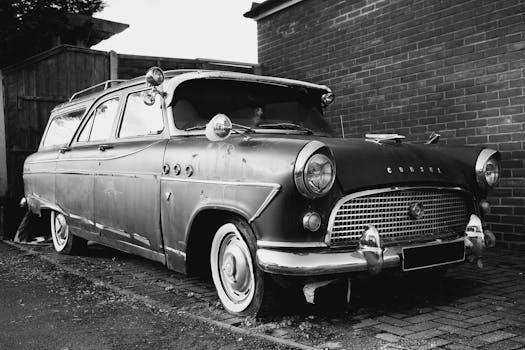The 1995 Ford F-150 offered a 5-speed manual transmission option, catering to drivers who preferred a more engaging driving experience. This setup is a key feature for understanding this classic truck. Known for its robust nature, the manual transmission was often paired with the 4.9L inline-six engine or other available engine sizes. This transmission gives the driver greater control over gear selection, enhancing its rugged capabilities.
Overview of the 1995 Ford F-150
The 1995 Ford F-150, a ninth-generation model, stands as a testament to Ford’s commitment to durable and versatile pickup trucks. This model year featured a range of configurations, including two-door pickup options, with a variety of trim levels available for diverse consumer needs. The F-150 was offered with both manual and automatic transmissions, allowing buyers to select their preferred style of driving. Powering this workhorse were various engine choices, most notably the inline-six 4.9-liter engine and the V8 options, each designed to offer a balance of power and reliability. The manual transmission variant, specifically, appealed to those who appreciated enhanced control and a more hands-on driving experience. Known for its robust construction, the 1995 F-150 was designed to tackle both everyday tasks and more demanding work applications. This truck is a very important vehicle for the history of Ford. The truck offered a good balance of practicality, performance, and rugged style, making it a popular choice.

Manual Transmission Options
The 1995 Ford F-150 primarily featured a 5-speed manual transmission, with the Mazda M5OD being the most common option. A ZF 5-speed is also a possibility. These transmissions provided a variety of gear selections for different driving needs.
5-Speed Mazda M5OD Transmission
The Mazda M5OD, a 5-speed manual transmission, is a common sight in the 1995 Ford F-150. This transmission was manufactured by Toyo Kogyo, which is now known as Mazda. It’s a robust unit designed to handle the power of the F-150’s engines, including the 4.9L inline-six. This transmission is known for its smooth shifting and reliable performance in a variety of conditions. It has a reputation for being a workhorse, and provides the driver with a direct connection to the vehicle’s powertrain. The M5OD offers five forward gears and a reverse gear, allowing for flexibility in different driving situations. The 5-speed manual transmissions were available in both 4×2 and 4×4 configurations. This transmission is an integral part of the driving experience for many 1995 F-150 owners.
Possible ZF 5-Speed Transmission
While the Mazda M5OD is the more commonly cited 5-speed manual transmission for the 1995 Ford F-150, there is some mention of a possible ZF 5-speed transmission being used as well. It’s important to note that the ZF transmission was more commonly found in heavier-duty applications. However, there are discussions among enthusiasts about its potential presence in some F-150 models of this era, though these claims are not always fully confirmed. The ZF transmission is known for its robust construction and ability to handle significant torque. The ZF transmission was also used in other Ford vehicles, including vans and trucks. This transmission, if present, would provide a different feel and durability compared to the Mazda unit. It is a topic of interest for those seeking specific specifications.

Transmission Specifications
Understanding the specific gear ratios and the final drive is essential for the 1995 F-150 manual transmission. These factors directly impact the truck’s performance, towing capabilities, and fuel economy.
Gear Ratios and Final Drive
The 1995 Ford F-150’s manual transmission, typically the Mazda M5OD, featured specific gear ratios designed to optimize the truck’s performance across various driving conditions. These ratios determine the relationship between engine speed and wheel speed in each gear. First gear was a low ratio, providing ample torque for starting and heavy loads, whereas the higher gears are intended for cruising and fuel efficiency. The final drive ratio, found in the rear axle, plays a role in how engine power is delivered to the wheels. It’s a crucial consideration for towing and overall performance. The exact ratios for each gear varied slightly depending on engine configurations but typically included a low first gear around 3.7⁚1, a direct drive fourth gear (1⁚1), and an overdrive fifth gear, and a final drive ratio typically between 3.08⁚1 to 3.55⁚1.
Shift Patterns for 4×4
The 1995 Ford F-150 equipped with a manual transmission and four-wheel drive (4×4) utilized a specific shift pattern for engaging the transfer case, which controls the 4×4 system. The main manual transmission gear pattern remained standard, typically with five forward gears and reverse. However, the transfer case shifter, often located on the floor next to the main gear shift lever, had its own distinct pattern. Usually, this pattern included options for 2-high (2H), 4-high (4H), and 4-low (4L). Shifting into 4-high or 4-low required the truck to be at a complete stop or moving very slowly. Some models may have had a push-button transfer case. The 4-low setting significantly reduced the gear ratios, providing maximum torque for challenging off-road or towing situations. Proper engagement required understanding of this specific pattern and the correct procedure to avoid damage.
Maintenance and Issues
Maintaining the 1995 Ford F-150 manual transmission is crucial for its longevity. Common issues include fluid leaks, gear grinding, and excessive shavings. Regular fluid changes with the correct type are vital to prevent problems.
Transmission Fluid Type and Change
For the 1995 Ford F-150 manual transmission, using the correct fluid is paramount for optimal performance and longevity. Typically, these transmissions require a specific type of gear oil, often a 75W-90 or similar specification, although some owners have used 20W-50. It is critical to consult your owner’s manual or a trusted mechanic to determine the exact fluid recommended for your truck’s transmission type. The fluid change interval is also crucial, typically every 30,000 to 60,000 miles, or as recommended by the manufacturer. Regular changes ensure proper lubrication, reducing wear and preventing issues like grinding gears or excessive buildup of metal shavings. During a fluid change, it’s important to inspect the transmission’s magnetic drain plug for metallic debris; This can indicate internal wear and potential problems. Using the proper fluid and changing it regularly contributes to the smooth, reliable operation of the 5-speed manual transmission. Furthermore, proper fluid levels are also critical. Always use the recommended fluid and follow the fill level instructions during fluid changes.
Common Problems⁚ Shavings and Grinding
Owners of the 1995 Ford F-150 with a manual transmission might encounter issues such as excessive metal shavings in the transmission fluid and grinding noises during gear changes. The presence of metal shavings on the magnetic drain plug during fluid changes is a common sign of internal wear within the transmission. These shavings are often caused by worn bearings, gears, or synchronizers. Grinding noises, especially when shifting between gears, can indicate worn synchronizers, which are responsible for matching gear speeds during shifts. If grinding occurs, it’s also important to check clutch engagement. A worn clutch can also cause grinding. Ignoring these symptoms can lead to more serious and costly damage, potentially requiring a full transmission rebuild or replacement. Regular inspection and timely addressing of these issues will significantly extend the life of your transmission. Proper fluid and fill levels are also critical in reducing wear. Furthermore, these problems might be exacerbated by aggressive driving habits or improper gear changes. Early detection and proper maintenance can alleviate these problems.

Performance and Compatibility
The 1995 Ford F-150’s manual transmission is known for its ability to handle various engine sizes, offering a balance of performance and control. This manual transmission system ensures proper power transfer and truck capabilities.
Engine Compatibility with Manual Transmission
The 1995 Ford F-150’s manual transmission was designed to work seamlessly with a range of engine options available at the time, enhancing the truck’s versatility. Specifically, the 4.9-liter inline-six engine was a common pairing with the 5-speed manual, offering a robust and reliable powertrain configuration. This combination was favored by those who preferred a more hands-on driving experience with good low-end torque. The manual transmission was also available with other engine choices, though the 4.9L inline-six was a prevalent option. Compatibility was carefully engineered, allowing the transmission to effectively handle the various power outputs of the engine options. This ensured that drivers could harness the full potential of their chosen engine, whether for everyday driving, towing, or other work related tasks. The manual gearbox provided a direct link between the engine and the wheels, allowing for better control and responsiveness. This compatibility was a crucial factor in the F-150’s reputation for being a durable and dependable workhorse.
Manual Transmission with Different Engine Sizes
The 1995 Ford F-150’s manual transmission was offered alongside various engine sizes, each providing a distinct driving experience. The 4.9L inline-six was a frequent companion to the 5-speed manual, known for its workhorse performance. The manual transmission was also found with the 5.0L V8 engine, offering a different balance of power and torque. This pairing provided a more sporty feel compared to the inline-six. While less common, the manual could also be found with the larger 5.8L V8, further enhancing the truck’s performance capabilities. The manual transmission provided the driver with precise control over the engine’s power, allowing for a more engaged driving experience. This versatility in engine and transmission combinations made the F-150 a popular choice, allowing buyers to select a setup that best suited their individual needs and preferences. The adaptability of the manual across different engine sizes showcased its robust design and broad appeal among truck enthusiasts.

Additional Information
Remanufactured and rebuilt 1995 Ford F-150 manual transmissions are available with warranties, often up to 5 years. These options provide cost-effective solutions for owners. Availability of these units can vary based on the supplier.
Warranty for Remanufactured Transmissions
When considering a remanufactured manual transmission for your 1995 Ford F-150, the warranty is a crucial aspect to evaluate. Many suppliers offer warranties on their remanufactured units, often ranging from a limited period to an extensive coverage, sometimes up to 5 years with unlimited mileage. These warranties typically cover parts and labor, providing peace of mind against potential defects. It is essential to carefully review the specific terms and conditions of the warranty, as they can vary significantly between different providers. Some warranties may include additional benefits like flat rate shipping, and may have a no core charge for a certain period of time. Always inquire about the warranty’s specifics to ensure it aligns with your needs and expectations before making a purchase. This crucial step helps protect your investment in a rebuilt transmission.
Availability of Rebuilt Transmissions
Locating a rebuilt manual transmission for a 1995 Ford F-150 is generally feasible, given the truck’s popularity and the ongoing demand for replacement parts. Several sources, including specialized transmission shops, online retailers, and auto parts stores, offer rebuilt units. These transmissions are typically disassembled, cleaned, and reassembled with new or refurbished components to meet or exceed original specifications. The availability can vary depending on the specific transmission type, such as the Mazda M5OD. It is also worth noting that some suppliers may offer remanufactured units, which often undergo a more rigorous rebuilding process. When searching, it’s important to confirm the transmission’s compatibility with your truck’s engine and drivetrain configuration. Always verify the source’s reputation and the transmission’s condition before making a purchase. Rebuilt transmissions offer a cost-effective alternative to new ones.


